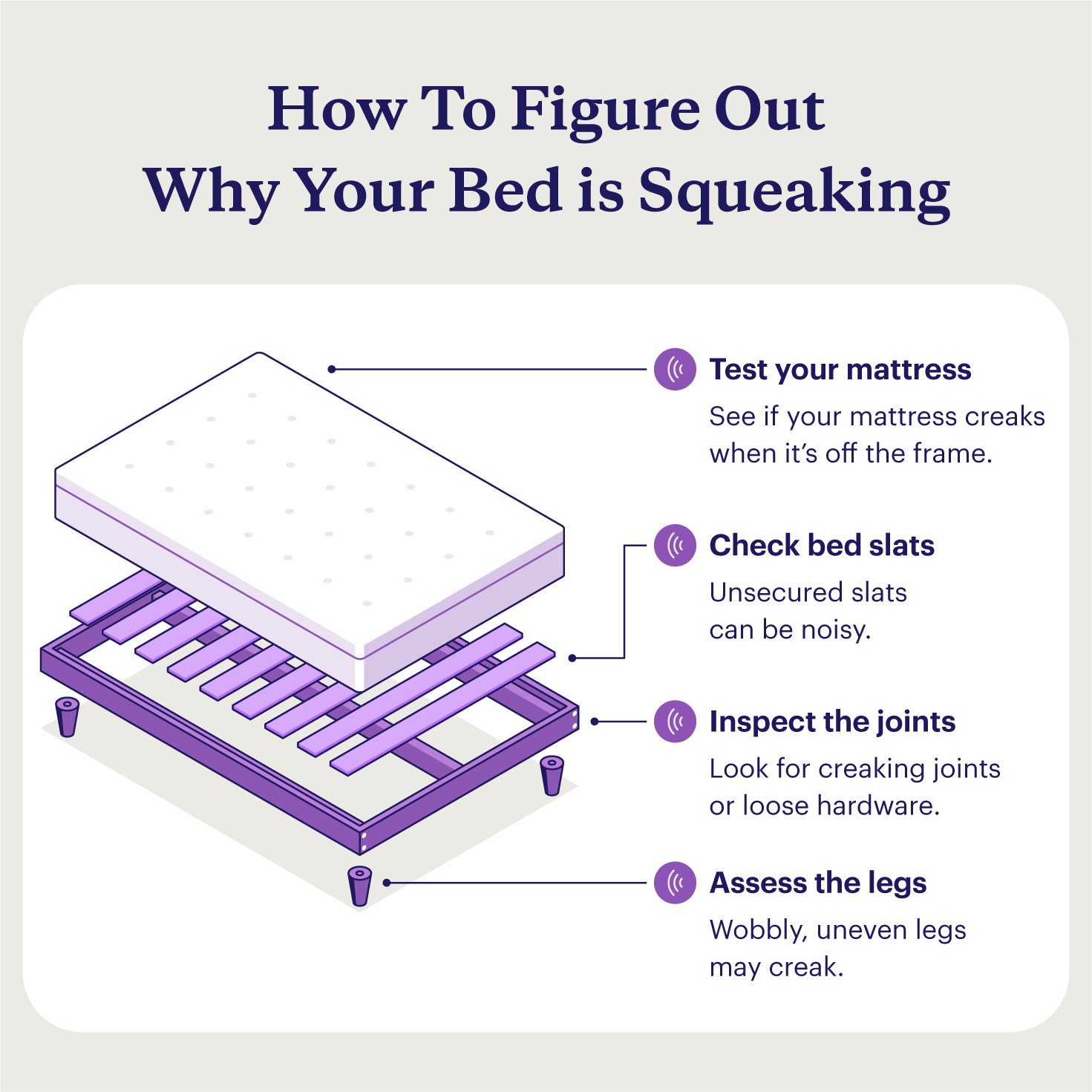
How To Fix a Squeaky Bed: 11 Tips for Uninterrupted Sleep
Key Takeaways
- Friction is the main cause of a squeaky bed, often due to loose joints, worn-out materials, or rubbing surfaces.
- Your mattress, bed frame, or floor could be to blame. Noise can come from aging springs, unstable frames, or direct contact with the floor.
- Common fixes include tightening bolts, adding padding, rotating your mattress, or upgrading worn-out parts.
You’re settling in for the night, but every time you move, squeak. It's that annoying sound that won’t let you rest. A squeaky bed may impact your health more than you realize, leading to restlessness, incomplete sleep, or even sleep deprivation. In some cases, persistent squeaking can be one of the signs of a bad mattress.
Sleep is necessary to recharge your body, boost your immune system, and improve your mood. When something gets in the way of deep, restful sleep, it’s worth fixing.1,2
But how do you fix it if you’re not sure what’s causing it?
Read along to learn why your bed is squeaky, the common causes behind it, and simple fixes to help you sleep soundly again.
How To Stop Your Bed From Squeaking
A squeaky bed is usually an easy fix. Start by finding the source: mattress, box spring, or frame. Then, tighten loose parts, reduce friction, or add padding to silence the noise.
1. Identify What’s Squeaking
Before you can fix a squeaky bed, you need to find the source. It could be anything — the mattress, box spring, bed frame, or even the floor underneath.
Press on different areas while listening closely. If the noise comes from the mattress, worn-out springs or internal friction may be the cause. If it’s the frame, loose bolts or rubbing joints could be to blame. For beds on hardwood floors, shifting the frame slightly or adding a rug may help dampen the sound.
If the box spring is the issue and beyond repair, you may need to dispose of your box spring and replace it.
Mattresses may squeak because of age, pressure, or friction. If the noise comes from an innerspring mattress, worn-out coils could be the issue. In that case, replacing it may be the best fix.
2. Rotate Your Mattress
Rotating your mattress is one of the easiest ways to reduce squeaking. Over time, mattresses wear unevenly since most people tend to sleep in the same spot. When you rotate your mattress, you distribute weight more evenly, which can help extend its lifespan.
Here’s how to rotate your mattress:
- Remove any sheets, pillows, or bedding.
- Grip the edges — or handles, if your mattress has them.
- Turn it 180 degrees so the head of the mattress moves to the foot.
- If your mattress is flippable, turn it over so the bottom faces up.
For the best results, aim to rotate your mattress every three to six months. Before rotating, check if your mattress brand encourages rotating or advises against it. Newer mattress models often do not need to be rotated.
3. Support With Plywood
If you've tried rotating your mattress and are still hearing squeaking, it might be time to improve the quality of your mattress foundation. A weak or uneven base can cause unnecessary movement, which can lead to noise and discomfort.
One way to promote a strong mattress is by inserting a thin plywood slat underneath it.* Choose a piece that is at least three-quarters of an inch thick, with sanded and rounded edges to prevent damage to the mattress. Confirm with your mattress manufacturer if this temporary solution is okay for your mattress, as this could void warranties for some brands.
For a long-term solution, consider upgrading to the Purple Flat Foundation for sturdy, noise-free support.
*This is not advisable for Purple mattresses. Confirm with your mattress manufacturer if this temporary solution is okay for your mattress, as this could void warranties for some brands.
4. Try a Mattress Topper
A mattress topper can help reduce squeaking while adding a layer of comfort, especially if you have an innerspring mattress. The added cushioning helps absorb movement, reducing friction between the mattress and its foundation.
One benefit of this is a well-supported mattress can help improve sleep quality by reducing pressure points and discomfort.3 While it won’t fix a heavily worn mattress, it can provide a temporary noise reduction solution.
5. Tighten Loose Joints
Over time, bolts, screws, and other hardware can loosen due to regular movement, eventually compromising your bed’s support.
To help reinforce your bed frame, you can:
- Inspect all joints: Check where the frame connects, especially at corners and support beams.
- Tighten loose bolts or screws: Use a wrench or screwdriver to secure any that have loosened over time.
- Add washers if needed: If a bolt won’t stay tight, placing a washer between it and the frame can improve stability.
- Replace worn or damaged hardware: If screws or bolts are stripped or damaged, changing them for new ones can help reinforce the frame.
Checking and tightening these connections can help eliminate unwanted creaking and prevent further wear and tear.
Building your bed frame can result in loose joints or lost screws, but you don’t need to worry about assembling a Purple Bed Frame. We ship it folded in on itself directly to your door, so you can set it up with ease — no tools required — for convenient, quiet support.
6. Use Oil or Wax
If your bed frame squeaks, lubricating the joints can help silence the noise. Depending on the type of bed frame you have, you can use different products to reduce squeaking.
For squeaky metal bed frames, consider a non-corrosive oil like WD-40 or a silicone-based lubricant, one that you can easily apply to your frame with a rag or cloth.
For wooden bed frames, wax is a better option. Rubbing beeswax, candle wax, or furniture wax helps smooth the surface and prevents noise. Make sure you use a wood-friendly wax, like beeswax, to avoid harming the wood’s integrity.
7. Cushion the Frame With Cork
Cork can be a quick and easy way to solve a squeaky wooden bed frame. Simply wedge small pieces of cork between any wooden slats or joints that are rubbing together to buffer the problem areas.
While cork works well as a temporary fix, it’s not a long-term solution. If the squeaking continues, consider other options to help you permanently reduce squeaking sounds from your bed’s wooden frame.
8. Add Padding Between Slats
If your bed frame has wooden slats, placing padding between them can help cushion the frame and reduce squeaking. Soft materials like towels, socks, or old clothing can act as a buffer, preventing the slats from rubbing against the mattress or frame.
As a result, this added cushioning can help make for a quieter, more restful sleep.
9. Get Floor Padding
If your bed squeaks when you move, the noise might be coming from friction between the frame and the floor. Adding padding underneath can help reduce movement and soak up sound.
Placing a rug, non-slip furniture pads, or folded fabric under the bed’s legs can minimize noise and prevent slipping. This works on all floor types, including carpet, wood, and tile.
If you’re also looking to adjust your bed’s height, look into ways to make your bed higher for additional support options.
10. Invest in a New Bed Frame
If your bed frame is old or damaged, replacing it might be the best long-term fix. Squeaking that comes from deep within the frame or box spring can be hard to repair, and a worn-out foundation can affect both noise levels and sleep quality. Ongoing sleep disruptions may also lead to short and long-term health problems.4
Upgrading your bed frame also gives you the chance to find one that better suits your needs. Whether you’re looking for improved support, increased airflow, or added height, the right mattress foundation can make a big difference in comfort and durability.
11. Upgrade Your Mattress
If there’s no easy fix to your squeaky mattress, it might be time for a new mattress. Over time, internal parts like springs and padding wear down, which cannot be fixed from the outside.
Upgrading your mattress is also a great opportunity to improve sleep quality. Consider one that matches your preferred firmness while still offering support. Some of the best mattresses feature hybrid interiors with gel, coils, or multi-layered foam—similar to what’s featured in Purple’s GelFlex® Grid mattresses — all of which promote a comfortable night’s sleep.
Why Is My Bed So Squeaky?
Squeaky beds can make it difficult, sometimes impossible, to sleep at night.
If your bed is creaking more than usual, one of its components may be wearing out. If movement is also a problem, consider ways to reduce motion transfer for more sound sleep.
Your Mattress Is Wearing Out
Over time, the materials inside your mattress can break down, leading to more noise and less support.
If your mattress is the suspected cause of squeaking, rotating, flipping, or changing your sleep position, it may offer a temporary fix. If the squeaking continues, it may be time to invest in a new mattress for a better long-term solution.
Tip: Replace your mattresses every 7-10 years.
Your Box Spring Is Aging
Your old box spring may be the source of squeaking if its wooden frame rubs against internal coils or slats. These materials wear down over the years, making the noise worse.
An easy way to reduce squeaking is to center your mattress to avoid added pressure on the edges. Adding padding between the box spring and frame may also help.
Tip: Replace your box spring every 8-10 years.
Your Bed Frame Is Noisy
A noisy bed frame is often caused by metal parts scraping together or wooden slats shifting under pressure. As a result, pressure over time could cause squeaking sounds.
If you think your bed frame is the source of squeaks, check where the frame’s corners or slats meet and listen for noise as you shift your weight. Tightening bolts, adding padding, or lubricating metal joints can help reduce squeaks.
Tip: Replace your wooden bed frame every 7-10 years and your metal bed frame every 15 years.
Silence the Squeaks With a Supportive Mattress From Purple
A squeaky bed can disrupt sleep and make it harder to get comfortable. Simple fixes like tightening bolts, adding padding, or rotating your mattress can help, but if the noise stays, it could be a sign it’s time for a change.
Investing in a high-quality Purple mattress and frame can provide lasting support and comfort without the added noise. If your mattress is aging, knowing how often to replace your mattress can help you decide when it’s time for an upgrade.
FAQ
Creaking usually happens due to friction between parts of your bed, like loose joints in the frame, worn-out mattress springs, or contact between the bed and the floor. Movement and pressure can make the noise worse over time. Tightening hardware, adding padding, or replacing worn components can help eliminate the sound.
Yes, WD-40 or a silicone-based lubricant can help silence a squeaky metal bed frame by reducing friction at joints and connection points. Simply apply it to bolts, screws, and areas where metal parts rub together.
To fix a squeaky wooden bed, tighten all screws and bolts, apply wax to rubbing joints, and add padding between slats and the frame. Cork, felt, or fabric can help absorb movement and reduce noise.
More To Explore
Level up your sleep routine with our most-loved products.












